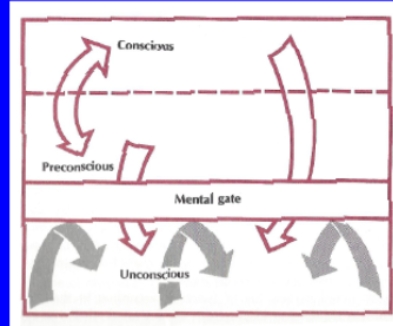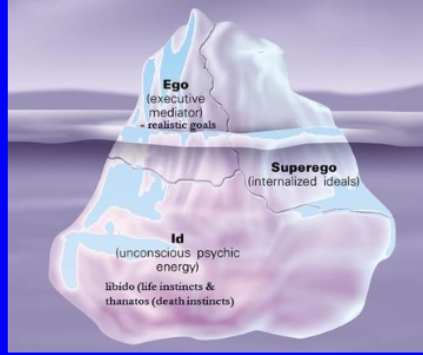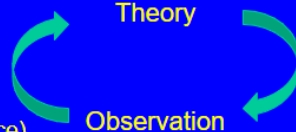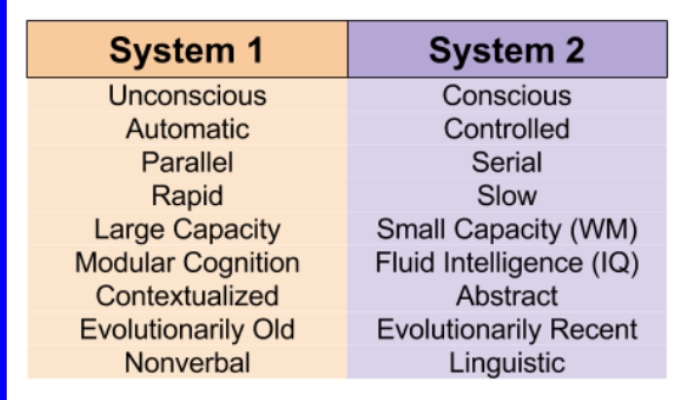Reason and Intuition Exam 1
1/54
There's no tags or description
Looks like no tags are added yet.
Name | Mastery | Learn | Test | Matching | Spaced |
|---|
No study sessions yet.
55 Terms
Unconscious vs conscious mind
Autopilot vs pilot, system 1 vs. system 2, elephant vs rider
Descartes’ Dualism
Mind and body are two different things. Mind is thinking and body is physical. “I think therefore I am” important because proves something is thinking and your body can’t think therefore your mind and body are separate.
Biological reasons for unconscious processing
Breathing, heartbeat, sweating, digestion, etc. Too much energy to constantly focus on these. Efficient routines for perception, attention, memory, and action. Needed for back then when there is a predator you can’t think if you need to run or think if it’s dangerous you just need to survive.
Why have consciousness at all?
To have behavioral flexibility: The ability to be aware of ourselves and our environment and to think about different responses. Crucial for surviving in a changing world.
Baars (1998) reason for consciousness
Central hub to distribute information throughout the brain, control voluntary actions,
Freud background
Trained as medical doctor, worked on aphasia (brain injury), assumed that reason drove human behavior, psychoanalysis
Freud’s topographical model
Mental gate blocking unconscious from getting out.

Freud’s Structural Model of the Mind
Id, ego, superego

Id: Unconscious
Fully unconscious. Basic instincts, desires, and drives (hunger, sex, and aggression). Operates on the pleasure principle: seeking immediate gratification.
Ego: Unconscious, preconscious, and conscious
Operates across all three levels of awareness. Rational part of the mind that balances the id’s impulses with reality. It follows the reality principle and mediates between the id and the superego.
Superego: Mostly Unconscious, but also Preconscious and Conscious
Contains our moral values and societal rules. Some aspects (like our internalized sense of guilt) are unconscious, while others (like our conscious moral reasoning) are accessible.
Ego employs defense mechanisms
Defense mechanisms are ways that the ego unconsciously tries to decrease internal conflict between superego, id, and reality
Avoidance: Primitive defense mechanism
Dismissing uncomfortable thoughts or feelings, staying away from people, places, or situations associated with uncomfortable thoughts or feelings
Denial: Primitive defense mechanism
Dismissing external reality and instead focusing on internal explanations or fallacies and thereby avoiding the uncomfortable reality of a situation
Repression: Primitive defense mechanism
Subconsciously blocking ideas or impulses that are undesirable
Displacement: Higher-level defense mechanism
Transferring one’s emotional burden or emotional reaction from one entity to another
Intellectualization: Higher-level defense mechanism
The development of patterns of excessive thinking or over-analyzing, which may increase the distance from one's emotions
Reaction Forming: Higher-level defense mechanism
Replacing one’s initial impulse toward a situation or idea with the opposite impulse
Freud and dreams: Revealing the Id (subconscious)
Dreams reveal id because the mental gate (the ego) is down. Ego is thought to not be active during sleep.
Projective tests to reveal unconscious information
Show you photo and ask what you see. Not very reliable. Low test-retest reliability. Some clinicians use as starting point/discussion
Scientific Theory
Account for existing facts
Make predictions about new facts
Tested in different ways (lines of evidence)
Can be falsified (can be proven wrong)

Freud’s Psychoanalysis
His theory of personality and a therapeutic approach focused on exploring the unconscious mind. It suggests that human behavior is driven by unconscious thoughts, desires, and conflicts, often rooted in childhood experiences.
Critiques of psychoanalysis
Based mostly on Freud’s anecdotes about patients
Hard to make predictions that can be falsified (childhood trauma leads to neurosis but if they’re not neurotic it’s because the trauma is being repressed)
No clear efficacy vs. other therapies
Strengths of psychoanalysis
Essentially, it served as a starting point
Sleep wake cycle and consciousness
“Lose” consciousness every night and “get it back” every morning
System 1 vs System 2 Image
Meant to minimize effort and maximize performance

Just finished first slide show
Good job!
System 1 basic principle
We are aware of the products but not the process of cognition
WYSIATI: What you see is all there is
People make judgements and decisions based off only on the information they have and do not consider what they don’t know, System 1. Explains why people fall for biases, stereotypes, and misinformation.
Expectation vs perception block example
Large block and small block of equal weights. People applied more force to lift bigger box because they assumed it weighed more. Participants reported the smaller box to be heavier after lifting even though they weighed the same. B/c they applied more force to bigger box and didn’t expect the strain from smaller box, so they believed smaller to be heavier.
System 1 and hallucinations
False because not induced by sensory information from outside world. True because person has vivid experience of perceiving something.
Memory works as a contructive process
Think of it as a Wikipedia page: you can go in there and change it but so can other people
Misattribution: 7 sins of memory
Remember information correctly but assign it to the wrong source. Hear it from a friend but later believe you read it in an article. Deese-Roediger-McDermott (DRM) Task: presented list of words like bed, rest, dream, tired, and snooze and participants recalled hearing the word sleep even though it was not presented. Relates to availability bias.
Suggestibility: 7 sins of memory
External information distorts your memory. This often happens through leading questions or misinformation, like in eyewitness testimony. Ex. If someone asks, “Did the man in the red jacket steal the purse?”, you might remember a red jacket even if it wasn’t there.
Suggestibility and retroactive interference: 7 sins of memory
New information interferes with old memories, making it harder to recall the original. It’s related to suggestibility because misinformation introduced later can override your initial memory. Ex. You learn a new phone number and later struggle to recall your old one.
Bias: 7 sins of memory
Memory bias happens when our current beliefs, feelings, or knowledge influence how we remember the past.
Bias: Consistency bias: 7 sins of memory
This specific bias makes us believe that our past attitudes, beliefs, or behaviors were more consistent with our present views than they actually were. We rewrite our past to match our current self.
Just finished power point 2
Good job!
Insert powerpoint 3
Over system 2
Judgement involves
deciding on the likelihood of various events using incomplete information
Decision making
Involves selecting one option from several possibilities
Heuristics are
shortcuts to judgement and decision making
Hindsight bias
"knew-it-all-along" effect, is when people believe—after an event has happened—that they predicted it all along, even if they didn’t.
We see past events as more predictable than they actually were.
We forget our original uncertainty or misjudgments.
It can make us overconfident in our decision-making.
Happens because we want to make sense of the past
Peak end rule
we judge an experience based mostly on two key moments:
The Peak – The most intense (positive or negative) moment of the experience.
The End – How the experience concluded.
A long, painful procedure is recalled as less unpleasant if the pain lessens toward the end.
Fading Affect Bias (FAB)
Tendency for negative emotions associated with memories to fade faster than positive emotions over time. This means that as we recall past events, negative memories lose their emotional intensity faster than positive ones, helping us maintain a more positive outlook.
Finished power point 4
Good job!
Availability heuristic
The tendency to judge the frequency or likelihood of an event by the ease with which relevant instances come to mind. It operates on the assumption that if something can be recalled, it must be important or more important than alternative solutions that are not as readily recalled
Anchoring effect
People latch onto information (anchor) and let it affect their decision even if it is completely irrelevant,
Anchoring and Adjustments
Only adjust a certain amount away from anchor
Representative heuristic
people judge the likelihood of an event based on how similar it is to an existing stereotype or prototype in their mind. Instead of considering actual probabilities, we rely on how well something "represents" what we expect.
Is bob (creative, plays cello, artistic) more likely to be in an orchestra or be a farmer? People assume orchestra but statistically it’s farmer
Conjunction Fallacy
Assuming that two conditions together are more probable than one alone
Assume Linda is a bank teller and active in the feminist movement rather than one or the other when really it’s just one because of stats
Simulation heuristic
judge the frequency or likelihood of an event by the ease with which you can imagine (or men-tally simulate) an event.
Getting second hurts more than third because you could imagine first
Missing train by 5 min is more frustrating than missing it by 45 even though in both cases nothing else is different
Base rate heuristic
people tend to ignore statistical information (base rates) in favor of specific, anecdotal, or representative information when making judgments.
Scenario:
Medical Diagnosis Mistakes
A rare disease affects 1 in 10,000 people. A test for the disease is 99% accurate.
If someone gets a positive result, many assume they definitely have the disease.
However, because the disease is so rare, the actual probability of having it is still very low.
💡 Base Rate Neglect: People ignore that most positive test results will be false positives because they focus only on the accuracy of the test.
AIM heuristic: Affect as information
Imagine a child who lives with a cuddly collection of well-mannered dogs who comes across a strange dog. Also imagine a second child who was recently bitten severely by the neighbour’s cocker spaniel. The former child will asso- ciate dogs with pleasant feelings and will unconsciously judge the risk in saying hello to the new dog as low and the benefit as high. The latter child will associate dogs with fear and pain and will judge the risk in getting close to the strange dog as high and the benefit as low. Without thinking about it, the former will probably approach the dog in question, whilst the latter will not. Both children display the affect heuristic in action – an involuntary emotional response that influences decision-making.